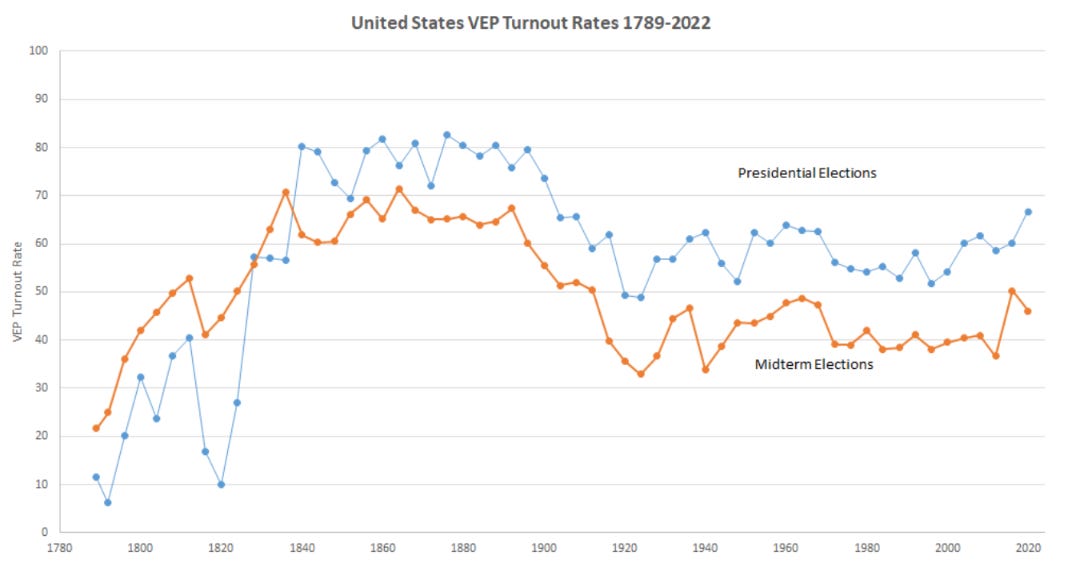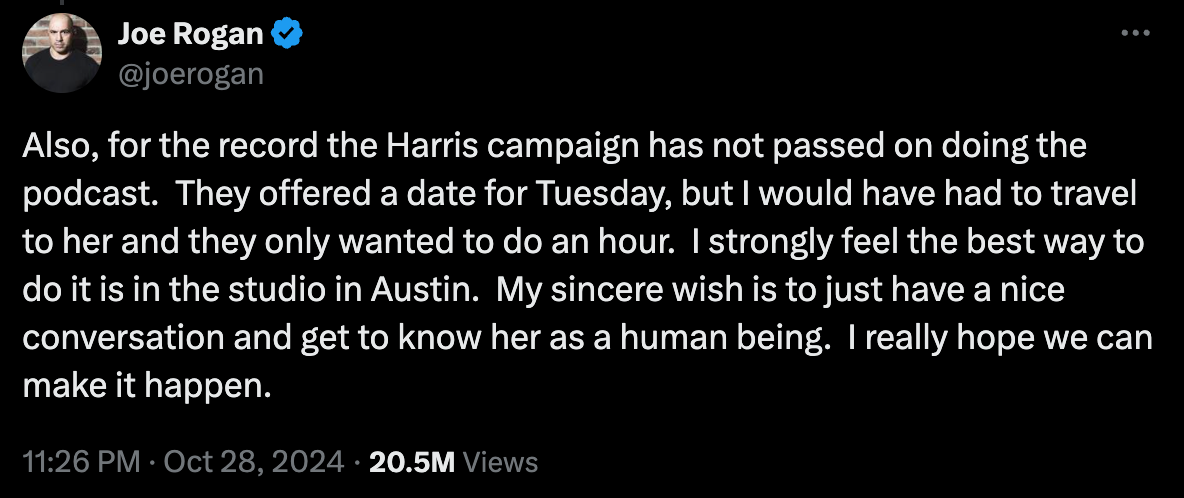How Does Your Vote Actually Get Counted and More: The Presidential Election Guide
Your weekly News Memo - a more human way to engage with the news.
+ GetSmart: 👶🏼 At 23 Weeks, a Baby Learns His/Her Mother’s Voice
The News Memo is a reader supported venture. If you find it helpful or want to support our mission, consider becoming a paid subscriber.
Newsbites
Stat of the Week: Voter participation rates in the U.S. (about 67% in 2020).
Boeing raised more than $20B through the sale of additional stock this week. The sum provides Boeing needed liquidity as it continues to burn cash, and will help the company avoid having its credit status downgraded. The labor strike of more than 30,000 machinists continues to persist after the union rejected Boeing’s latest offer last week - extending the production freeze on the 737 jet. In addition, it has been reported that Boeing’s new CEO is considering selling the space segment of its business (working with NASA) to cut costs and generate additional funds.
The Metropolitan Detention Center (MDC) in Brooklyn, which is currently holding Sean “Diddy” Combs and other high-profile prisoners, was subject to an “interagency operation” on Monday. The operation, which involved the Justice Department and other law enforcement agencies, was intended to help maintain “a safe environment for both our employees and the incarcerated individuals.” The Federal Bureau of Prisons said there was no active threat at the jail. However, the MDC has been under scrutiny for the unsafe conditions at the facility. For example, in September, 9 inmates were charged with violent attacks, including murder, against fellow inmates.
More: MDC is now the only active federal prison in NYC after the Metropolitan Correctional Center (MCC) closed in 2021 due to bad conditions. Jeffrey Epstein was being held at MCC when he died in 2019.
North Korean Troops in Russia: Around 8,000 North Korean troops are in Russia close to the Ukraine border, according to U.S. officials. “We’ve not yet seen these troops deploy into combat against Ukrainian forces but we would expect that to happen in the coming days,” Secretary of State Antony Blinken told reporters. Russia has been reportedly training the NK troops on “basic infantry operations, including trench clearing, indicating that they fully intend to use these forces in front line operations.” One of the main concerns revolves around what military technologies the North Korean regime could receive from a partnership with Russia.
More: On Thursday, North Korea launched an intercontinental ballistic missile test for the first time in over a year.
4 in 10 Americans vote early: According to a recent Gallup poll, 40% of American voters intend to or have already cast their vote before election day, through mail-in ballots or in-person early voting. Gallup predicts that number could reach 50% before the election on Nov. 5. Early voting in presidential elections has consistently increased since 2004. Although Republicans did not tend to vote early in 2020, the messaging from the GOP and Trump campaign has switched this election and is promoting all methods of casting votes. (see main story below for more on the election process).
Trump on Rogan followup: The 3-hour interview between Trump and Joe Rogan took the internet by storm last week racking up more than 42M views on YouTube within a week. Rogan posted the full interview on X after YouTube users were unable to find the full interview. Rogan said, “Since there's an issue with searching for this episode on YouTube here is the full podcast with Trump.” The X post has received nearly 20M views. The episode was also available on Spotify which does not show analytics to the public. On Thursday, Rogan also released a podcast with Trump’s running mate JD Vance. Harris and Rogan have not set a date to do an interview. Below is his response.
Biden calls Trump supporters “garbage”: While Kamala Harris was making her final pitch to American voters at the site where Trump spoke on Jan. 6, President Biden was just miles away in the White House speaking on a teleconference hosted by Voto Latino where he made a controversial statement about Trump supporters: Here is the full quote during the call: “Just the other day, a speaker at his [Trump’s] rally called Puerto Rico a ‘floating island of garbage…’ The only garbage I see floating out there is his supporters.” (full video with full quote)
More: Trump arrived in Wisconsin the next day wearing a garbage man outfit and was picked up by a garbage truck with Trump branding. He continued to wear the outfit during his rally.
How Does Your Vote Actually Get Counted and More: The Presidential Election Guide
Why it matters: There are already reports that the election results might not be finalized until days or weeks after Nov. 5. The News Memo would like to give you a brief overview of how presidential elections work so when the craziness hits on Nov. 5 you have a general idea of what’s going on.
How it works
While voters in all 50 states will head to the polls on Nov. 5, the voting process differs across states. The reason is because the Constitution leaves election processes up to the states. Article I section 4 reads:
"The Times, Places and Manner of holding Elections for Senators and Representatives, shall be prescribed in each State by the Legislature thereof; but the Congress may at any time by Law make or alter such Regulations, except as to the Places of choosing Senators."
Although a high percentage of people will vote on the day of the election in person, millions of Americans will have already cast their ballots in early voting and through the mail.
A rundown of voting methods: Mail-in ballots have gained adoption
Early Voting – States typically have a period of time before the election in which people can either mail in a ballot or go to a voting location in-person.
Mail-in / Absentee – Mail-in voting encompasses any votes that are cast through the mail. In 2020, an estimated 43% of votes were cast by mail, compared to 21% in 2016. In the past, a larger portion of mail-in ballots were related to absentee voters, i.e., those in the military, those hospitalized, those living in a different state from their home residence. In these cases, most states would require absentee voters to provide a reason for why they needed a mail-in ballot.
However, in the wake of the pandemic, more states altered their laws to allow for broader use of mail-in ballots, without needing to provide a reason.
28 states offer “no-excuse” absentee voting, which means voters can request a mail-in ballot without providing a reason.
8 states and Washington D.C. conduct all elections by mail. In this case, all registered voters in the state are mailed ballots ahead of the election. Voters are typically required to sign an affidavit attesting their vote. A number of other states allow certain counties or small precincts to conduct elections by mail (Minnesota, for example).
The remaining 14 states require voters to have a reason to request an absentee ballot.
Many states allow polling places to begin counting mail-in ballots before Election Day. However, states such as Wisconsin and Pennsylvania do not begin tallying mail-in ballots until the morning of Election Day, while other states wait until after the polls close to begin counting.
Further, most states require a mail-in ballot to arrive at the polling place by Election Day in order to be counted. However, some states, such as California, will count mail-in ballots that arrive up to seven days after Nov. 5 if the ballot envelope was postmarked on or before Election Day.
In-person at the polls – Apart from 2020, this still accounts for the majority of votes.
How are votes actually counted? We spoke with Minnesota officials to check
In Ramsey Count, MN, for example, votes are counted in the following way. Election judges, which are typically residents of the county that are appointed or sign up to work the polling stations, collect the ballots. Voter registration lists are maintained to see if someone has already cast a mail-in ballot or not to prevent double voting.
Completed ballots are then fed into a ballot tabulator that tracks the votes received for each candidate. The machine is non-networked, meaning it is not connected to the internet. After the polls close, the ballots and election results are sealed, locked in a box and physically sent to the state Elections Office, where they are added with the results of other counties. An audit is conducted to check if votes were counted properly. The canvassing board then certifies the results.
Read Wisconsin’s process here.
Voter ID laws
Given each state can set its own rules, voter ID requirements vary across the U.S. 36 states require some form of identification (ranging from a photo ID to non-photo ID). 14 states require no document to vote. In these states, voters are simply required to provide their signature, address, date of birth, or sign an affidavit attesting they are eligible to vote.
For example, in Minnesota, there is no ID requirement for registered voters. In order to register to vote in Minnesota, one must provide address verification. This can be done by presenting a driver’s license, for example, or a utility or internet bill that lists the person’s address.
For perspective on voter ID laws, every country in Europe requires photo IDs in order to vote. Further, about 75% of European countries ban absentee voting for citizens living within the country.
The Electoral college explained
The Constitution laid out what we now call today the “electoral college” which gives each state a certain number of electoral votes determined by the population of each state as explained below.
How the number of electoral votes per state is determined
Senate Seats: Each state has two Senators, regardless of its population, which guarantees two electoral votes.
+
House of Representatives: The number of Representatives each state has is based on its population. The more populous the state, the more Representatives it has. Each Representative adds one electoral vote.
=
The total number of electoral votes for a state is the sum of its Senate seats (two) and its House Representatives.
Formula
2 (Senate seats) + Number of Representatives (based on population)
For example:
California has 53 Representatives in the House and 2 Senators, making its total electoral vote count 55 (2 + 53).
One of the two candidates needs to reach 270 electoral votes to win the election. This will undoubtedly come down to these seven swing states:
Arizona, Nevada, Wisconsin, Michigan, Pennsylvania, North Carolina and Georgia.
If no candidate wins a majority of electoral votes, the House of Representatives votes for the president.
Insight: use this interactive map to see how the election results will change depending on who wins any of these swing states.
When will we know the results of the election?
Generally the results of the election are called by approved news agencies such as Fox News, Associated Press, CNN etc. They can call the “projected winner” whenever their data shows a big enough lead from the exit polling. However, the official results are not certified until days or weeks later.
At the latest, states must certify votes by December 11, more than a month after the election. In the 2000 race between George W. Bush and Al Gore, given the recount in Florida, a winner was not called until December.
TRENDS: The U.S. Has Underbuilt Homes For the Past 15 Years
Keep reading with a 7-day free trial
Subscribe to The News Memo to keep reading this post and get 7 days of free access to the full post archives.







